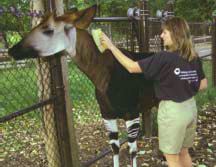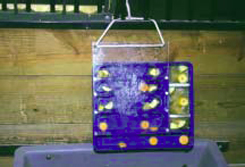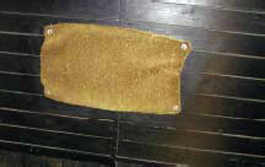Enrichment



It is important that we strive to maximize opportunities to encourage
the okapi’s natural repertoire of behaviors in their environment.
These activities help engage animals both mentally and
physically, and help minimize, or eliminate, negative or unwanted
behaviors.
Some examples of enrichment are:
- spending time with
their keeper
- offering choice browse or smaller portions of their
diet throughout the day
- novel items that catch their attention
- Depending on the animals involved, allowing social opportunities
or providing new areas to explore all contribute to a healthy and
well-adjusted animal
Food items are often the choice for enrichment by allowing for
unlimited opportunities of browsing throughout the day.
It should
be noted that enrichment food items should not exceed the normal
diet amounts. Food enrichment provides for needed oral stimulation
that might otherwise become negative obsessive behavior.
There is a number of approved browse species
utilized at each
institution and a variety of ways it can be offered.
Food items can be used for enrichment:
- Daily cuttings of branches and leaves can be located at a variety of heights
- Alfalfa can be offered in different types of containers and hung to
encourage natural foraging overhead
- Safe, novel objects like balls
that have rough or smooth surfaces, or traffic cones, or even food
puzzles, also encourage exploration
A survey completed in 1999
by 11 holding institutions provides information on how various
plantings are utilized in outdoor enclosures. While some vegetation
is occasionally browsed, most offer other aspects of enrichment
for the animals such as, shade, security or cover, or for urine
marking by the males.
Non-food items are also used for enrichment:
- Okapis will rub
their necks on edges of objects
- Natural-fiber floor mats have been
attached to walls or posts for additional rubbing locations
- Tips of
branches are utilized to scratch the inside of their ears
- Groupings
of branches hung from above provide cover to hide behind when
startled
- Solid partitions ~4 feet tall and 6-8 feet long offer cover
and at the same time, allow the animal to observe activity from
behind by only exposing its head at one end to observe
HUSBANDRY GUIDELINES
FOR THE OKAPI SSP - Sept 2004
Edited by Terry DeRosa, San Antonio Zoo,
Fran Lyon, White Oak Conservation Center and
Ann Petric, Okapi SSP Coordinator, Brookfield Zoo
Illustration: J. Busch
Updated and adapted for the web, Patrick Immens